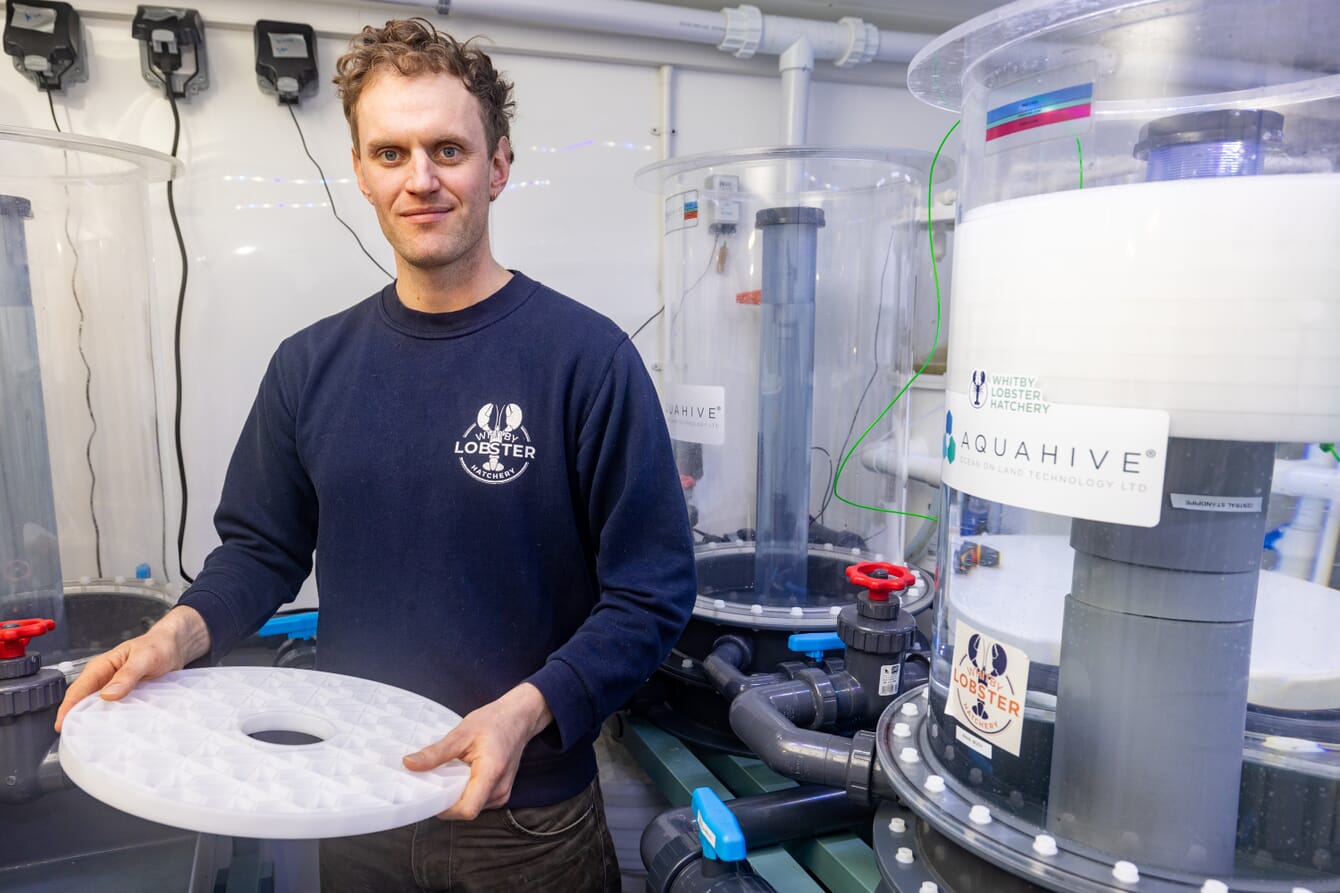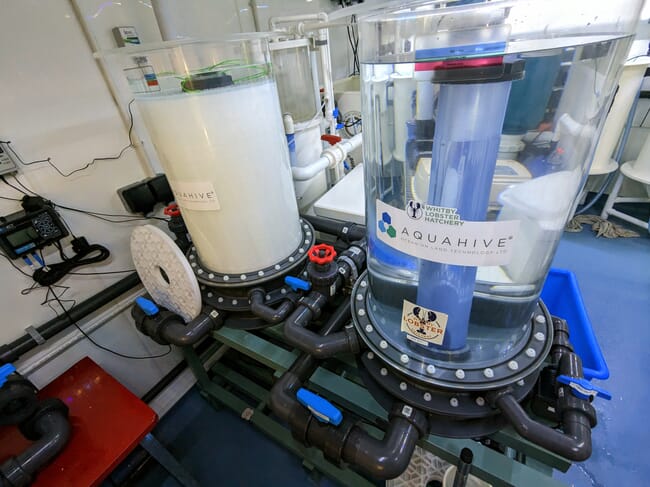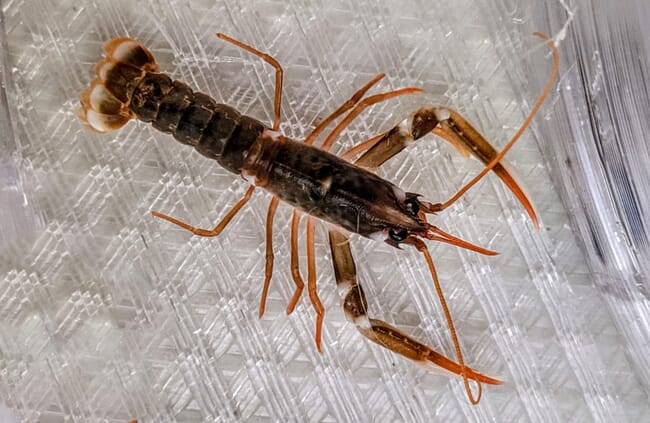
Its full tourist season in Whitby and down on the waterfront hundreds of visitors from all over the world mill past the port’s old fish auction market, enjoying their fish and chips and watching the boats go by.
However, in the old fish market building something is happening, which will soon be another big draw for this famous Yorkshire town’s thriving tourist industry: an aquaculture-based conservation project.
It’s August and Joe Redfern, a marine biology graduate originally from Leeds, is supervising a team of contractors from Weymouth to build and fit out the new visitors’ centre for the Whitby Lobster Hatchery. Earlier in the morning Redfern had begun his regular daily maintenance and running tasks at the hatchery, which has been operational since March 2023.
After completing his degree in 2017 Redfern travelled to Australia and other parts of the world, getting involved with diving and marine conservation work, but soon wanted to come back to Yorkshire to contribute his skills locally. For 18 months he worked in Whitby for the Inshore Fisheries Conservation Agency (IFCA). Funded by the local council, his work often involved going out on the boats with local fishermen.
As Redfern explained, historically the local white fish industry – which focused on catching cod, haddock and flatfish – peaked in the 1990s, when nearly 27 trawlers were operating out of Whitby. But now there’s only one whitefish trawler remaining, following a demise in the industry that Redfern puts down to factors including overfishing.
However, many of these fishermen diversified into brown crab (Cancer pagurus) and European lobster (Homarus gammarus) fishing. And the town now has 25 of these boats, which use pots to trap the crustaceans, and land approximately 100,000 lobsters annually – a 400 percent increase since 2005.

The lobster hatchery on Whitby's harbour front restocks the local waters in the northeast with juveniles to help improve the long-term prospects of the fishing industry
The early days
In the spring of 2020, around the time of first Covid lockdown, Redfern’s contract with IFCA ended and he took to working with local lobster and crab fishermen. This led him to meeting a number of locals working in the value chain, including wholesale merchant Terry Pearson. Around that time there was also good evidence showing the beginnings of decline in local crab and lobster stocks in the northeast, through a CEFAS report. This was one of the catalysts for what then followed.
It was through Pearson that Redfern first heard of plans to start a lobster hatchery on the harbour front, that aimed to restock local waters with juveniles, thereby improving the long-term prospects of the fishery. Redfern immediately wanted to get involved. And with Pearson and other local folk working across the value chain, they started crowd funding, raising £26,000 – enough to pay for a proper pre-feasibility study.

The hatchery is designed with three separate purpose-built RAS units and a 50,000-litre water storage tank, with saline water needing to be pumped on average once every two weeks
There quickly followed increasing interest from local newspapers, and even national TV, as the old fish auction rooms were secured – both as a prime location for the hatchery and as an attraction for tourists with potential for future income generation. However, both Redfern and Pearson knew that significantly more capital would be required to get a hatchery off the ground, so started fundraising in earnest. They were well aware that the other two UK lobster hatcheries – in Padstow and North Berwick – had adopted business models incorporating eco-tourism to achieve socio-economic viability.
Things began to further look up when an £80,000 grant from the Marine Management Organisation was secured, quickly followed by a further funding from offshore windfarms run by Scottish Sustainable Energy (SSE) and Sofia Dogger Bank. From these the core equipment for the hatchery was bought and installed and the Whitby Lobster Hatchery was born.
By late 2021 a charity trustee organisation, North Sea Conservation, was officially set up and registered. They then approached Anglo American Mining (AAM), who run a potash mine just outside Whitby, who donated £95,000 in early 2022, allowing the charity to employ a full-time aquaculturist.
Meanwhile, a community interest company was formed, specifically for the visitor centre. The company started under the condition that 65 percent of annual profits from the visitor centre would be available to be invested back into the hatchery, thereby ensuring an operating model where future income from the visitor centre would be driving the whole project.
The technical design for the hatchery was carried out by the specialist Orkney-based company Ocean on Land and ecopreneur Giles Cadman, who also financially supported the early development of the project. The water inlet is located 100m from the quayside hatchery building in the harbour. And the hatchery is designed with three separate purpose-built RAS units and a 50,000-litre water storage tank, with saline water needing to be pumped on average once every two weeks.
Salinity levels vary, depending on tidal state and rainfall, and water temperatures seasonally range between 5°C and 20°C. A three-phase electricity supply allows seawater to be pumped into the hatchery, where it then goes through a comprehensive filtration process – including a slow sand filter, ozone, carbon filter, mechanical filtration bags and then finally ultraviolet (UV), thereby removing suspended solids, pollutants and potential pathogens.
The operation of the hatchery is based on local fishermen catching and bringing in egg-carrying (berried) females. These can produce up to 20,000 eggs per cycle, and are kept in optimum conditions for hatching. Out in the North Sea, storms, potential diseases and pollution result in around 1 percent survival rate for these very delicate juveniles, but according to Redfern those in the hatchery have a 30-50 percent greater chance of survival.
Juveniles are fed multiple times daily, on a special Artemia-based diet, for 14 days to reach stage 4 (post-larval stage). The 2cm-long juveniles are then transferred to a specially designed tank, called an Aquahive. This individually isolates each juvenile to prevent cannibalism, and they are fed an optimised diet, allowing rapid growth up to the time they are large enough to be released into the sea.

The 2cm-long juveniles are transferred to this tank, which individually isolates each juvenile to prevent cannibalism, where they are fed an optimised diet that allows for rapid growth until they are large enough to be released into the sea
The project is very much born out of the desire from the local fishing industry to try and become more sustainable and resilient for the future.
As Redfern explains: “We work with the fishermen to get berried hens, which are the egg-bearing females, and we let the larvae hatch from the eggs in the hatchery. The hatchery then protects the juvenile lobsters from predators, storms and other factors such as bacteria which young lobsters are susceptible to. In the wild the larvae have a low chance of survival, so we protect them, giving them the diet they need to boost their chance of survival and once they are ready, we release the juvenile lobsters into the sea where they will fortify the existing lobster population for years to come.”
It is currently illegal in UK for commercial fishing boats to land berried females, so the hatchery arranged a special dispensation from the Marine Management Organisation (MMO), allowing local lobster fishermen to bring them in as the hatchery broodstock. There are currently four designated commercial boats that have been supplying the hatchery with berried females, and at the time of my visit the hatchery was holding 14 of these broodstock animals.
In the spring of 2023 the hatchery released its first 343 juveniles on the seaward side of the east pier and is on track to hit its target for releasing a total of 10,000 juveniles this year. It has longer term ambitions, and the capacity, to release over 100,000 juveniles per year. These juveniles take five to seven years to grow to both breeding and market size.
Although Redfern has been the only full-time employee to date, he notes that he has received help and support from a number of local, dedicated volunteers including Terry Pearson, James Cole, Mike Russel and Linda Wild, who have helped the hatchery develop and increase its capacity.
However, the visitor centre is likely to open in the autumn and Redfern says they will soon be employing another aquaculture specialist, thanks to another generous donation from the Woodsmith Foundation, which is also linked to the local Anglo American mine.

Juveniles are fed multiple times daily, on a special Artemia-based diet, for 14 days to reach stage 4 (post-larval stage) before being transferred to the Aquahive tank for the final growth stage before being released into the sea © Whitby Lobster Hatchery
Further research required
Redfern reflects there are still a number of unknown issues to resolve before the future of the hatchery and its long-term success can be ensured. These include the need for clear data on the percentage of hatchery-reared juveniles that reach maturity 5-7 years after being released. Evidence-based estimates on the necessary numbers of hatchery-reared juveniles which need to be released into a certain area of the coastline to result in a self-sustaining population of adult lobsters are also pertinent.
Other key research questions needing to be answered include: the optimum size and weight to release juveniles and the optimum coastal locations – including water quality, depth, temperature, seabed substrate and ecology – to release them. The answers to many of these questions, Redfern reflects, are still unknown.
While it’s still early days, from the idea’s inception in 2019 as an empty, vacant fish auction building on the quay, in just three years Whitby harbour has seen a true transformation and now proudly boasts a working lobster hatchery and associated visitor centre for the benefit of its local fishermen, its townsfolk and local economy, as well as for the thousands of tourists who will flock to see it from all around the world.
If you wish to find out further details about the hatchery, please email Joe Redfern or visit the website.




